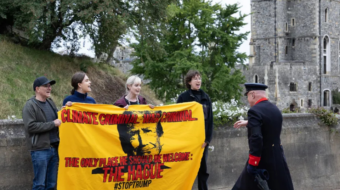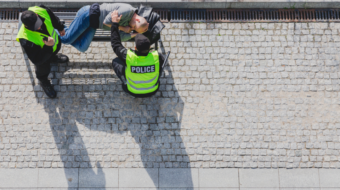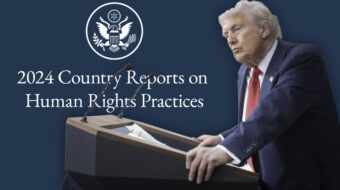
This article first appeared at www.mltoday.com.
Prisoner David Ravelo recently presented two historical reports – excerpts are below – that, centering on Barrancabermeja, offer a local and intensely personal perspective on struggle in Colombia for rights and survival. The two victims Ravelo writes about were his comrades. For him, they were also heroes, along with others in his native city. Ravelo himself is a hero, we think.
For North Americans largely unaware of the U. S. hand in Colombia’s political chaos and humanitarian crisis, Ravelo provides a crash course. He testifies to ramifications in Barrancabermeja of U. S. interventionist policies toward Colombia.
Anti-communist objectives informed U. S. backing for a “national security state” in Colombia. Since 1964, the U. S. government has provided financial, material, and personnel support for the Colombian government’s war against the leftist Revolutionary Armed Forces of Colombia (FARC). U. S. military experts at the time counseled Colombia’s government to insert paramilitary capabilities into its counterinsurgency program. Colombia’s U. S. – backed military and police forces went on to collaborate with paramilitaries.
Colombia’s brand of counterinsurgency has extended to civilian society. Ravelo’s first-hand reporting documents the resulting murder and mayhem that descended on Barrancabermeja. He builds the case for U. S. complicity.
In his recollections, historian Ravelo becomes a reporter as he provides background information bearing on pressing news today. Violent repression is on the rise now in Colombia, and on that account Colombia’s current peace process is stumbling. FARC negotiators are balking at their insurgency being subjected to violent attacks in a time of peace, as happened back in the era Ravelo is writing about. What he records reflects their worst fears.
Barrancabermeja’s history encapsulates Colombia’s long record of social revolution, militarization, violent repression, and lost promises. Located on Colombia’s huge Magdalena River, Barrancabermeja hardly existed until 1921 when the Standard Oil affiliate Tropical Oil Company established its refinery there. Leslie Gil, revealingly enough, titled his new book “A Century of Violence in a Red City.”
There, labor leader Raul Eduardo Mahecha founded the oil workers’ union known as the Syndicated Worker Union (USO), now Colombia’s “most militant and powerful” union, according to Gil. “Class conflict in Barrancabermeja was pervasive, raw, and violent,” Gil says.
The Patriotic Union (UP) looms large for Ravelo. The FARC and the Colombian government in 1984 agreed that the guerrillas would give up arms and enter electoral politics. Together with communists and other leftists, they formed the UP electoral coalition which ran candidates for local and national offices. Then murders began; over decades, thousands of UP activists died throughout Colombia.
Cesar Martínez Blanco
Ravelo titles the first of his reports “Ten months that shook Barrancabermeja.” Excerpts follow:
Cesar Martínez Blanco arrived in Barrancabermeja at the end of the 1950s. He became a Communist Party militant when he was young. He worked as a barber… his activities were centered in the commercial sector next to the Libertadores Theater. … Most days from six in the morning on he toured the districts of Barrancabermeja on foot. This won him love and affection from the people of Barrancabermeja who on several occasions elected him to the city council … He was my teacher in the art of political organization.
At 7 PM April 22, 1987, Cesar Martínez Blanco, member of the Patriotic Union (UP) leadership [and two others] were gathered in a store in La Campana district … They had just left a meeting … Suddenly someone threw a grenade. It exploded leaving the three leaders and others gravely wounded.
Immediately the wounded were transferred to the San Rafael Hospital. We congregated outside and were told that they had amputated Cesar Martínez’ legs. … Perplexed and grieving, we decided to take over the strategic location known as As de Copas. The action would begin at 10 PM and we made arrangements with Diego Rodríguez … to bring Patriotic Union militants from the northeast districts there in his bus.
By 10 PM, As de Copas was totally packed with people. [Soon] the barricade was organized. … The following day at eight AM, As de Copas was boiling over. People were there from every corner of the city, as were union, communal, and civic leaders … Ismael Jaimes and the present writer were invited to speak with Mayor Juan de Dios Alfonso García.
[The mayor indicated] he couldn’t do anything. Judicial power – deaf, dumb, and blind – didn’t function. We knew the public force had inspired the bloody deeds. There came the moment when we asked ourselves whose hands we were in. There was one option: to utilize social protest as a legal means for being able to publicize the grave humanitarian crisis through which we were passing.
When we returned to As de Copas, we discovered the Army had attacked the demonstrators, destroyed the barricade … Highway 28 became the scene of a pitched battle between the Army and demonstrators … We held a meeting at the headquarters of the National USO with USO leaders and leaders of the People’s Coordinating Center. We agreed to organize the civic strike [and] called for a big march at 4 PM to go from the refinery entrance to the As de Copas.
The mobilization was well attended…On reaching Highway 28, the march was attacked by the Army and again there was a pitched battle … The civic strike for the right to life went on for two more days … We learned that the public security forces that criminally attacked Cesar Martínez and the others had forced a woman living in the El Centro section to flee the city. And, more serious, the child Sandra Rondón Pinto was murdered May 4, 1987 next to her home in La Campana district. She had just attended morning mass. She supposedly had witnessed the criminal attack.
Manuel Gustavo Chacón Sarmiento
Ravelo’s second report, excerpted, appears next. Its title is the victim’s name.
We have a majestic photo showing an open stage with a huge background of sky covered by white clouds. They reflect the clarity of the thinking of the petroleum workers [in Barrancabermeja.]. Up there is Manuel Gustavo Chacón with his flute in full voice. These were days of epic deeds in the 1980s for the right to life … Manuel Gustavo was writing his poems and reciting them in the streets of Barrancabermeja, especially during civic work stoppages there. He did so at every barricade … It was common to see him going through the streets of the oil city with his wife and three children … [A]s an oil worker, he became a leader of USO … His presence at the union earned USO much support from the population.”
That day, January 15, 1988, Manuel Gustavo was walking through the street under the brilliant Barrancabermeja sun. At 10:30 in the morning he was in front of the little plaza by the old Telecom. There they shot him in the back from a small truck belonging to the National Army. There were 36 bullet holes. They used assault weapons from the Colombian state and ended his life.
People rose up spontaneously, having barely learned the tragic news. They packed the streets of Barrancabermeja. The People’s Coordinating Center, an organization that brought labor, religious, civic, social, and communal groups together, reacted to the community’s cry and called for a civic strike for the right to life. The present writer, representing the workers’ union at the Cooperative University of Colombia, was the Center’s leader.
The strike lasted four days and paralyzed production. USO decided to close down the refinery in Barrancabermeja to show the Colombia government its repudiation of the unpardonable crime. After the massive mobilizations … were over, and the shutdown of the city was lifted, paramilitary groups – their initials were M. A. S. – put out a pamphlet threatening death tor the protest organizers, among them, Fernando Acuña, Hernando Hernández, Wilson Ferrer, Eva Marín, and David Ravelo.
Francisco Pérez, a non-commissioned army officer, was sentenced to 16 years in prison. Other participating members of the public force enjoy total impunity.
Who is David Ravelo?
Ravelo entered Barrancabermeja’s city council in the 1980s as a member of the Patriotic Union (UP). He organized Barrancabermeja’s “Peace Council, “Social Forum,” the Workers’ Space for Human Rights, and the regional section of the MOVICE human rights organization. He founded and directed the CREDHOS human rights organization. In 2009, the Barrancabermeja Catholic Diocese honored Ravelo with its San Pedro Claver award for defending human rights over 35 years. A member of the Colombian Communist Party, he joined its Central Committee in 1991.
The state jailed him on false charges in 1993 – 1995. He and his family received death threats for many years. They accelerated as Ravelo led local resistance to mounting paramilitary attacks. On May 16, 1998, paramilitaries colluding with the Army and police killed 33 people; on February 28, 1999, eight more.
Ravelo’s denunciations helped put the lead perpetrator, paramilitary chieftain Mario Jaime Mejía, in prison. In 2007 Ravelo circulated a video showing ex-President Uribe socializing with Barrancabermeja paramilitaries in 2001. Taking revenge, officials reduced Mario Jaime Mejía’s sentence from 40 to eight years in return for false testimony against Ravelo. He was supposed to have arranged for the 1991 murder of a city official.
So armed, Colombian prosecutors arrested and jailed Ravelo September 14, 2010. His conviction and 18-year sentence were announced 26 months later. Judicial appeals failed. They’d been based on a law excluding criminals from Colombia’s judicial branch. Indeed, Ravelo’s prosecutor had been fired from the police force in 1991, having forcibly “disappeared” a youth.
In prison Ravelo has gained further exposure to the Colombian security state, bolstered by the United States. U. S. Plan Colombia featured an annex entitled “Program for Improvement of Colombian Prisons;” it provided funds for new prisons. U. S. consultants pushed Colombia to adopt a U. S. – inspired “prison – industrial model.” Now almost 10,000 political prisoners, Ravelo among them, are lodged in overcrowded prisons. Reports of contaminated food in prisons, water shortages, dangerous lack of medical care, and physical abuse are legion.
The author translated.
Photo: Manuel Gustavo Chacón Sarmiento.










